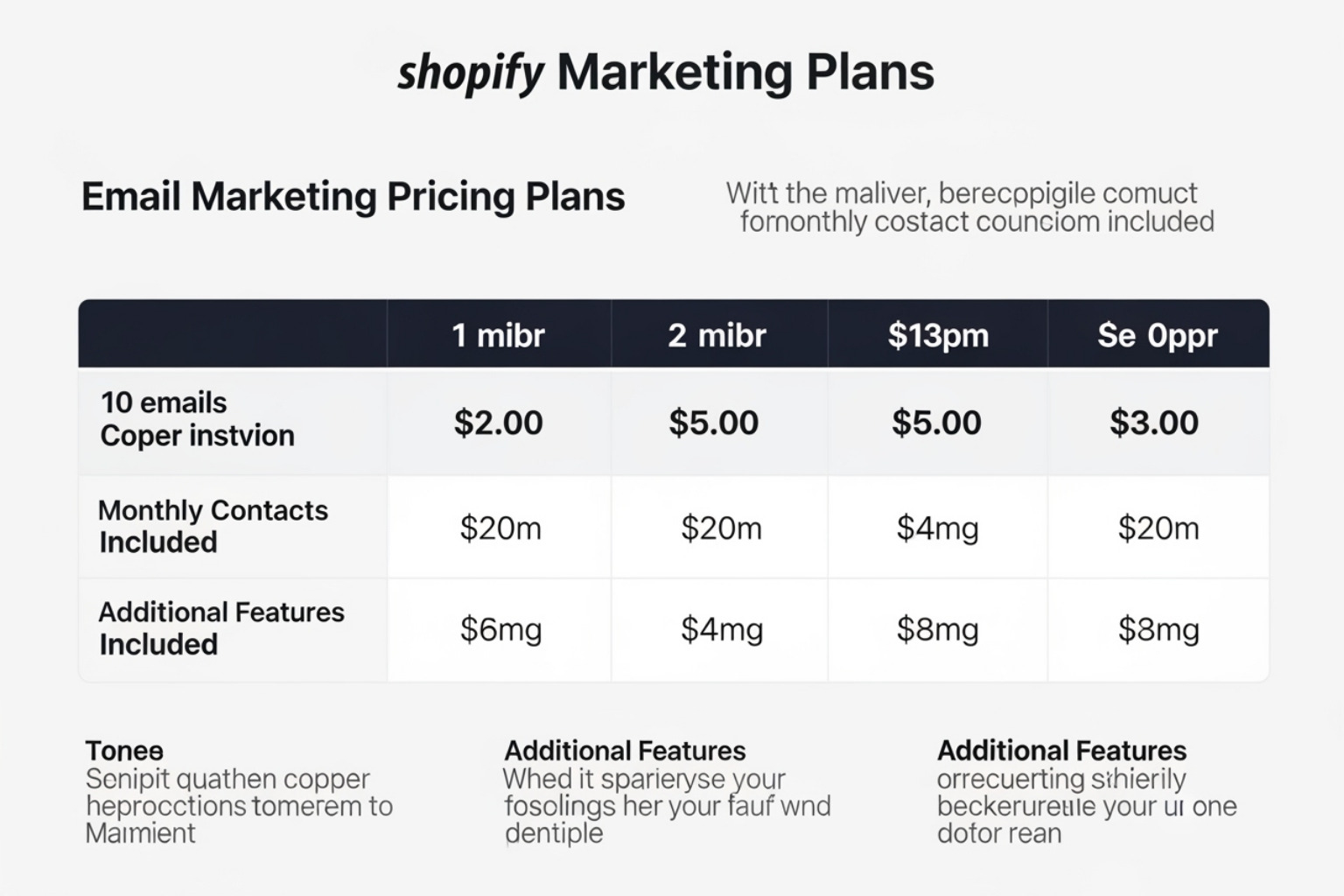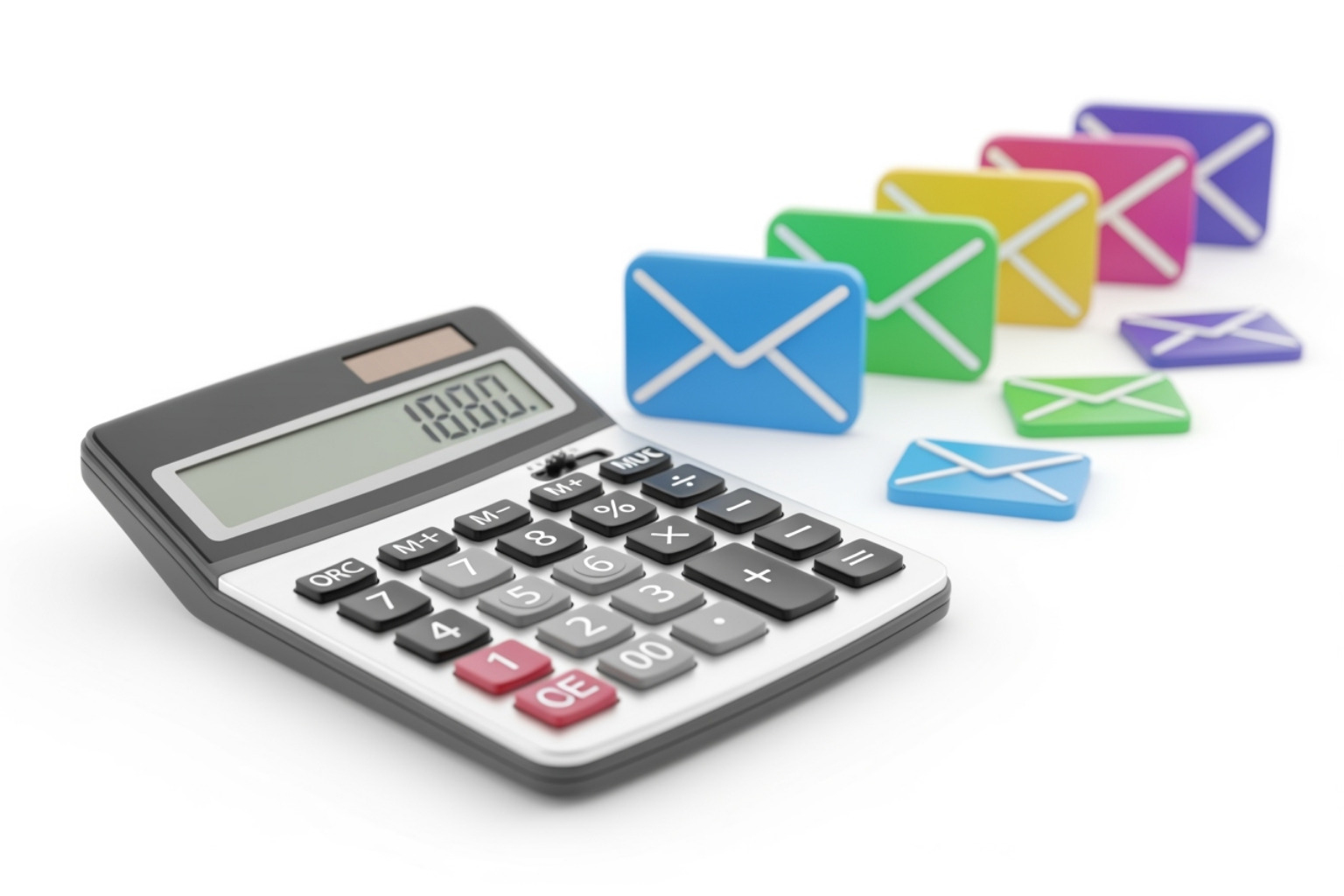Understanding Shopify Email Marketing Costs
What is Shopify Email and How Does It Work?
Imagine having an email marketing tool that feels like it was custom-made for your Shopify store. Well, that's exactly what Shopify Email is! It's Shopify's very own email marketing tool, built right into your online store's system. This means you can handle all your email campaigns directly from your Shopify admin area. No more jumping between different platforms or wrestling with complicated data exports. It's all there, in one place.
What makes this so powerful? It's the seamless integration. Shopify Email truly understands your business because it’s part of your business. It automatically taps into your existing customer data and product data. Think about it: you can easily use your customer lists, sales history, and even your product details to craft emails that really speak to your shoppers. This deep connection makes creating professional, on-brand marketing emails so much quicker and more efficient.
To start using this handy tool, you'll need an active paid Shopify plan. This includes stores on the Basic plan, the main Shopify plan, Advanced Shopify plan, and even Shopify Plus. It's super easy to get started – you can find and install the Shopify Email app directly from the Shopify App Store.
It’s truly designed with commerce in mind, which is a huge benefit when you’re thinking about your overall Shopify email marketing pricing strategy. This tool helps you keep everything streamlined and focused on growing your sales.
If you're curious to learn more about how email marketing can fit into your overall strategy, I recommend exploring our detailed guide on Shopify Email Marketing on our resources page.
A Complete Breakdown of Shopify Email Marketing Pricing
Now, let’s get to the heart of the matter: how much does Shopify Email cost? Shopify has a transparent and straightforward pay-as-you-go model that I believe is quite beneficial for businesses of all sizes, especially those just starting out or experiencing rapid growth.
Every calendar month, Shopify Email provides a generous free allowance. You can send up to 10,000 manual or automated emails without any additional charge. This free tier is a fantastic starting point, allowing you to establish your email marketing efforts without immediate extra costs.
After you use up your free allowance, Shopify Email operates on a pay-as-you-go basis. This means you only pay for the additional emails you send. It’s a commitment-free pricing model, which I appreciate because it gives you flexibility.
It's important to understand how emails are counted for billing purposes. Shopify counts emails based on each individual email address that an email activity is sent to. For example, if you send one promotional email campaign to 800 subscribers, that counts as 800 emails sent. It's not counted per campaign, but per recipient. So, if you send two campaigns in a month, each to 6,000 subscribers, that's a total of 12,000 emails.
One thing to note is that any unused emails from your monthly free allowance do not carry over to the next month. Each month, the counter resets, and you get a fresh 10,000 free emails.
Understanding the Costs for Additional Emails
Once you go beyond the initial free 10,000 emails, the cost structure is very clear. For additional emails, you're charged per 1,000 emails sent. Specifically, it costs $1 USD per 1,000 additional emails, which breaks down to just $0.001 USD per individual email. This rate applies until you reach a significant volume of 300,000 emails in a month.
Shopify also has a minimum billing threshold. You won't see a charge for additional emails on your bill until the accumulated cost reaches $0.005 USD. This helps ensure you're not paying tiny, frequent amounts for just a few extra sends.
Let me illustrate this with an example. If you send a total of 12,000 emails in a month:
- You use your 10,000 free emails.
- You then have 2,000 chargeable emails remaining (12,000 - 10,000).
- At $1 USD per 1,000 emails, those 2,000 additional emails would cost you $2 USD.
It's a straightforward calculation that allows you to easily estimate your potential costs.
Are There Volume Discounts for High-Volume Senders?
Yes, Shopify Email truly rewards high-volume senders with tiered pricing that makes it even more cost-effective as you grow. This is where the Shopify email marketing pricing becomes incredibly competitive for larger operations.
Here's how the volume discounts work:
- Up to 300,000 emails: As I mentioned, the rate is $1 USD per 1,000 emails after the free tier.
- After 300,000 emails in a month: The pricing for additional emails drops significantly to $0.65 USD per 1,000 emails.
- After 750,000 emails in a month: The pricing drops even further to $0.55 USD per 1,000 emails.
These automatic discounts mean that as your business scales and your email volume increases, your cost per email decreases. This is a smart way to help manage your marketing budget as you expand your reach.
You can learn more about the specific details of volume pricing directly from Shopify: Learn more about volume pricing.
How Shopify Email Marketing Pricing Appears on Your Bill
Understanding your bill is always important. The costs for additional emails sent through Shopify Email are clearly itemized on your monthly Shopify bill. You’ll find these charges listed as 'Marketing emails'.
To view the specific details of your Shopify Email costs, you can access the 'Billing' section within your Shopify admin. Here, you can see a complete breakdown of each email activity's cost, providing full transparency into your spending. I always advise merchants to check this regularly, especially as their email marketing efforts expand, to keep a close eye on their Shopify email marketing pricing.
Key Features Included with Shopify Email
Beyond its cost-effective Shopify email marketing pricing, Shopify Email comes packed with features designed to help you create effective and engaging email campaigns without ever leaving your Shopify admin. I find these built-in capabilities incredibly convenient for busy store owners.

One of the standout features is its simple email creation process. It offers a user-friendly drag-and-drop editor that makes designing beautiful emails easy, even if you have no design experience. You can choose from many pre-built templates that are made to help you sell more. What’s more, it automatically pulls your store’s branding, including logos, colors, and fonts. This helps you keep branding consistency across all your messages. You can even add express checkout buttons right into your emails, making it quicker for customers to buy.
Automation workflows are another powerful part. Shopify Email gives you ready-to-use automation templates for common e-commerce situations. You can set up:
- A welcome series for new people who sign up.
- Win-back campaigns to get old customers to come back.
- Upsell emails to encourage more purchases after a sale.
You can also create your own workflows to meet your specific marketing goals. This helps you reach customers at the perfect moment with the right messages. If you want to learn more about how automation can help your store, I suggest looking into Shopify Automation.
Customer segmentation is very important for sending targeted messages. Shopify Email lets you send campaigns to specific customer groups based on what they've bought, how they act, or other details. This helps make sure your messages are very useful to your audience, which leads to better engagement.
To help you see how well your campaigns are doing, Shopify Email includes a detailed analytics dashboard. Here, you can track important numbers like:
- Open rates: How many people opened your email.
- Click-through rates: How many people clicked on a link inside your email.
- Sales tracking: The money you made directly from your email campaigns.
This data is key for figuring out what works and what needs improving. It helps you make your strategy better over time.
Finally, Shopify also uses Shopify Magic AI to help with your email marketing. This AI tool can create great subject lines and email copy, helping you get past writer's block and save time. It can even suggest the best times to send your emails to get more clicks. While it’s a helpful starting point, I always advise looking over and editing AI-generated content. This ensures it perfectly matches your brand's voice and message.
It's good to remember that Shopify Email is mainly for marketing campaigns. For important messages like order confirmations and shipping updates, Shopify handles these automatically. For more details on these types of messages, you can find information about Shopify Transactional Emails.
Comparing Shopify Email's Value
When you think about Shopify email marketing pricing, it's helpful to see how Shopify's model stacks up against other options out there. Many email marketing services charge you based on how many subscribers you have, no matter how many emails you actually send them. Shopify Email, on the other hand, works on a pay-as-you-go system. This difference can be a real game-changer for many businesses.
The Cost-Effectiveness of a Pay-As-You-Go Model
The beauty of the pay-as-you-go model is simple: you only pay for what you actually use. You won't find a fixed monthly fee tied to the size of your email list. This can be super cost-effective, especially for businesses just starting out or those whose sending volumes change a lot from month to month. If you have a big list but only send emails occasionally, this model could save you a good chunk of money compared to a subscriber-based plan.
Let's take a look at an example to show you what I mean. Here's a quick comparison of Shopify Email's pay-per-send model versus a typical subscriber-based service. We'll imagine you're sending one email per subscriber each month.
| Monthly Sends | Typical Subscriber-Based Model (Example Cost) | Shopify Email (Calculated Cost) |
|---|---|---|
| 5,000 | $20 (for 5,000 subscribers) | $0 (within free tier) |
| 15,000 | $40 (for 15,000 subscribers) | $5 (10,000 free + 5,000 @ $1/1k) |
| 50,000 | $100 (for 50,000 subscribers) | $40 (10,000 free + 40,000 @ $1/1k) |
Please note: "Typical Subscriber-Based Model" costs are illustrative examples for comparison purposes only and vary widely among providers.
As you can see, for lower to moderate sending volumes, Shopify Email can be much more affordable. For instance, if your store sends 30,000 emails per month, your cost with Shopify Email would be just $20 USD. Even a store sending 600,000 emails monthly would only pay $485 USD. These figures often mean big savings compared to other services that might charge a lot more just because you have a large number of subscribers, even if you don't email them all that often. This approach makes it very friendly for new businesses and offers pricing that grows with you.
When to Consider Other Email Marketing Solutions
While Shopify Email is a powerful tool and quite cost-effective, it's also fair to say it has some limits when compared to highly specialized email marketing platforms. As your business grows and your email marketing needs become more detailed, you might start looking for more advanced features.
Some areas where Shopify Email might feel a bit simpler include:
- Advanced automation needs: While it offers ready-to-use workflows, very complex, multi-step automation sequences might be more robust in dedicated platforms.
- Complex segmentation: While you can segment your customers, some tools offer extremely detailed ways to group customers based on a huge range of their actions and data.
- A/B testing needs: Shopify Email’s A/B testing features might not be as full-featured as those you'd find in platforms built only for email marketing optimization. Some users have also mentioned they'd like more advanced features, like adding videos or GIFs right into emails, or having more precise control over font sizes.
In my experience, Shopify Email is a fantastic choice for small businesses and those who are just starting to grow. Its ease of use and how smoothly it works with your Shopify store make it perfect for getting started with email marketing without a big learning curve or a lot of upfront money. However, for very large businesses or those with super specific, highly advanced email marketing plans that need to connect deeply with other marketing channels, or require custom development, then exploring other solutions might be a good idea.
For a broader look at email and SMS marketing services, including options for those more advanced needs, you can find more information here: Email & SMS Marketing Services.
Best Practices for Your Shopify Email Campaigns
Regardless of the tool you use, effective email marketing relies on some core best practices. Here are some that I always emphasize for Shopify store owners:

- Audience segmentation: Don't send the same email to everyone. Divide your customer base into segments based on buying behavior, demographics, interests, or engagement levels. This allows you to send highly relevant and personalized messages, which significantly improves engagement rates.
- Personalization: Go beyond just using a customer's first name. Use customer data to recommend products, send birthday greetings, or tailor content based on past purchases. Personalization makes your customers feel valued and understood.
- Mobile-first design: A huge portion of your audience will open emails on their mobile devices. Over half of all web traffic now comes from mobile devices, so ensuring your emails look fantastic and are easy to read on small screens is non-negotiable. Always design your emails with mobile responsiveness in mind. You can find more data on mobile traffic here: Over half of web traffic is mobile.
- Verified sending domain: To improve your email deliverability and build trust with your subscribers, I highly recommend using a verified sending domain. This means sending emails from your own domain (e.g., newsletter@yourstore.com) rather than a generic address. Authenticating your domain helps prevent your emails from being flagged as spam and removes the "via shopifyemail.com" tag, making your brand look more professional.
- Tracking key metrics: Regularly check your email campaign performance. Pay attention to open rates, click-through rates, conversion rates, and unsubscribe rates. This data tells you what's working and what needs adjustment. Use these insights to iterate and improve your future campaigns.
- Legal compliance: Email marketing comes with legal responsibilities. Make sure your campaigns comply with regulations like the CAN-SPAM Act in the US, GDPR in Europe, and CASL in Canada. This includes providing clear unsubscribe options and being transparent about your data practices. You can find a helpful guide on the CAN-SPAM Act here: CAN-SPAM Act guide.
By following these best practices, you can maximize the effectiveness of your email marketing efforts and build stronger relationships with your customers, no matter which platform you choose.
Frequently Asked Questions About Shopify Email Pricing
I often get questions about the specifics of Shopify email marketing pricing. Let me address some of the most common ones that come up when store owners are planning their email marketing budget.
How are emails counted for billing in Shopify Email?
This is probably the most important question to understand. Emails are counted based on per recipient counting, which means each individual email address that receives your campaign counts as one email. So if you send a single promotional campaign to 5,000 subscribers, that counts as 5,000 emails towards your monthly allowance.
Here's a campaign example to make this clearer: Let's say you send a newsletter to 3,000 subscribers on Monday, then send a product announcement to 4,000 subscribers on Friday. That's a total of 7,000 emails counted for the month, not two campaigns. It's all about the total number of people who received your messages.
One thing that catches some people off guard is the unused free emails policy. Your 10,000 free emails reset at the beginning of each calendar month. Any unused portion from the previous month doesn't carry over to the next month. So if you only sent 6,000 emails in January, those remaining 4,000 free emails don't roll into February.
Are transactional emails included in the Shopify Email pricing?
This is a great question that I hear all the time! There's an important distinction between marketing vs. transactional emails that affects your billing. The good news is that essential business communications like order confirmations and shipping notifications are handled by Shopify's core system and don't count towards your email limits at all.
Password resets, account notifications, and other system-generated messages are also completely free. What's even better is that abandoned cart email policy is very generous - these recovery emails don't count against your 10,000 free email limit either. This makes sense because abandoned cart emails are crucial for recovering lost sales, and Shopify wants to help you succeed without penalizing you for these important touchpoints.
Is Shopify Email a good choice for a new or small business?
Based on my experience working with hundreds of Shopify stores, I can confidently say that Shopify Email is an excellent choice for new or small businesses. The cost-effectiveness is hard to beat - with 10,000 free emails per month, many small stores can run their entire email marketing program without any additional costs.
The generous free tier means you can start building your email list and sending regular campaigns without worrying about monthly subscription fees eating into your budget. I've seen startups successfully grow their customer base using just the free allowance for their first several months.
The ease of use is another huge advantage. You don't need to be an email marketing expert or hire someone to manage complex campaigns. The drag-and-drop editor and pre-built templates make it simple to create professional-looking emails that match your brand.
Perhaps most importantly, the seamless integration with your Shopify store means you're not juggling multiple platforms or trying to sync customer data between systems. Everything you need - your customer lists, product information, and sales data - is right there in your Shopify admin. This makes Shopify Email ideal for startups that need to keep things simple while they focus on growing their business.
As your business grows and your email marketing needs become more sophisticated, you can always explore additional tools, but Shopify Email provides a solid foundation that scales with you.
To Sum Up: Is Shopify Email Right for Your Store?
From my perspective, Shopify Email is a strong choice for many e-commerce businesses, especially if you're using the Shopify platform. Its Shopify email marketing pricing model is built around a generous free allowance each month, followed by a clear pay-as-you-go plan with discounts for higher volumes. This makes it very easy to get started with and also allows it to grow with you.
You really only pay for what you send. This is a big plus compared to other services that charge a fixed monthly fee based on how many subscribers you have. It's especially helpful for businesses that are just starting out or those whose email sending needs change a lot from month to month.
The tool itself is designed to be simple and easy to use. It works right inside your Shopify admin. This means you can manage all your campaigns without leaving your store's dashboard. Its ease of use, along with features like the drag-and-drop editor, ready-to-use templates, basic automation, ways to sort your customers, and analytics, makes it a great fit for many.
It's ideal for small and growing businesses that need an affordable and straightforward way to connect with their customers. It's also perfect for merchants who love the simplicity and convenience of having their email marketing fully built into their e-commerce platform.
While Shopify Email might not have every single advanced feature you'd find in highly specialized email marketing platforms, its main functions are solid enough to get good results for most Shopify stores. It's a powerful tool for building connections with customers, sharing news about new products, and helping to increase your sales.
If you're looking to build more advanced email strategies, or if you need expert help to truly make your email marketing shine, the team at First Pier is always here to lend a hand. Our deep knowledge of Shopify development and optimization means we can help you build successful online businesses from the ground up, including improving your email marketing approach.
Ready to improve your email marketing? Begin by exploring your options and refining your strategy with our resources on Shopify email marketing.







